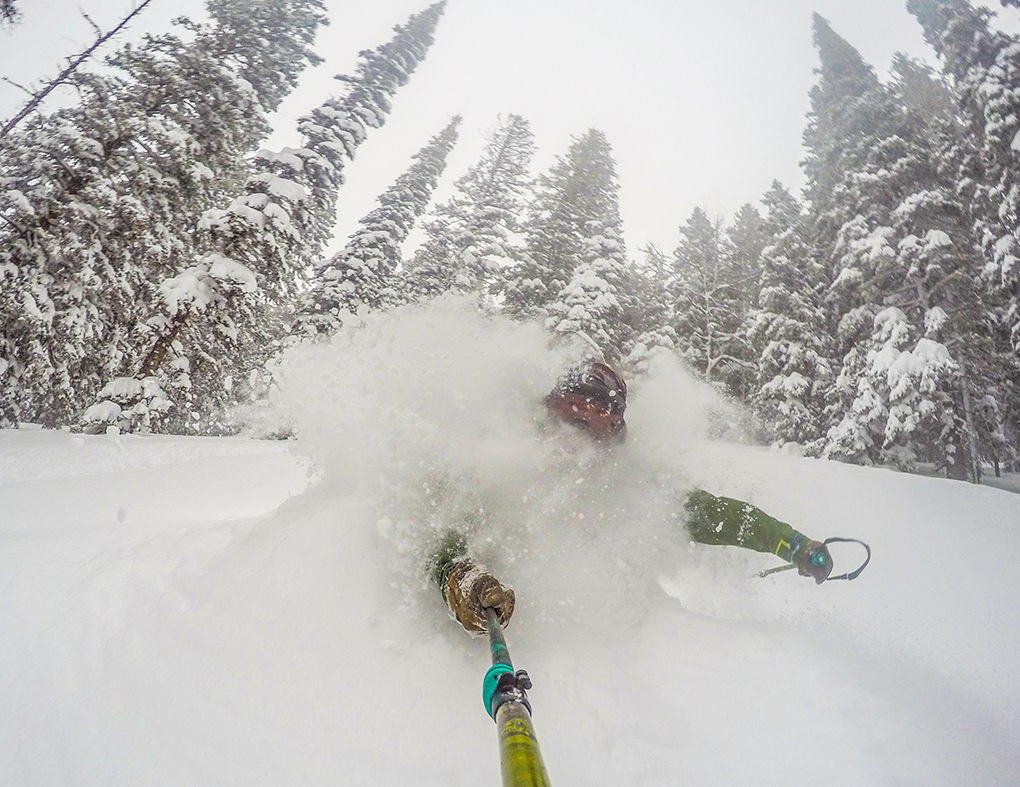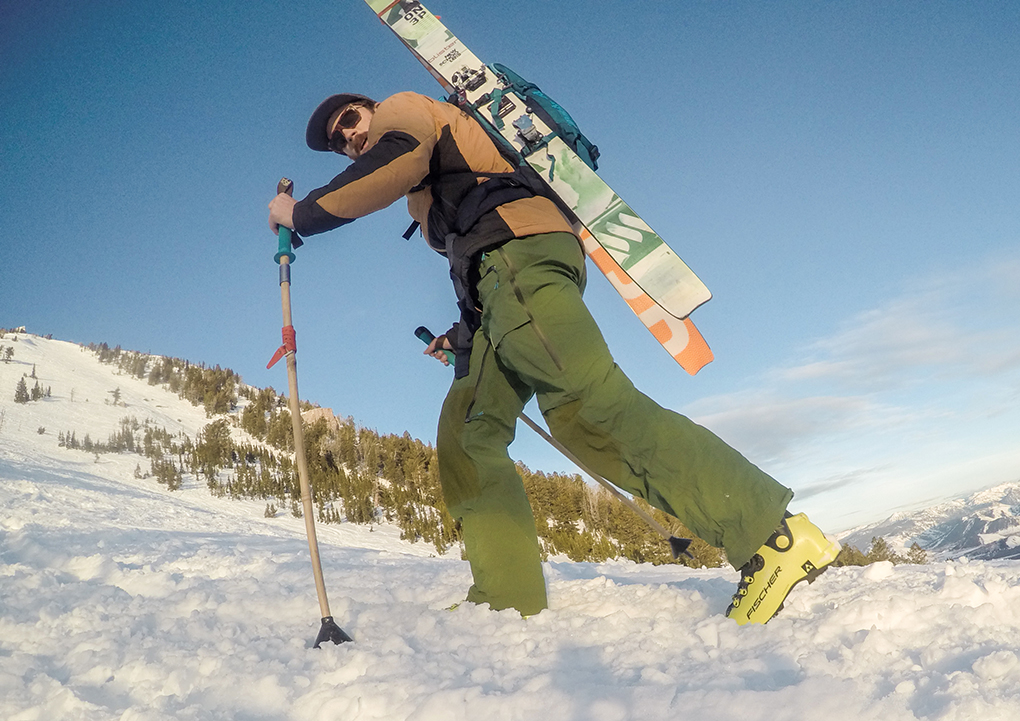Binding Compatibility
The Travers is only compatible with tech bindings, but it does have enough of a heel welt that it works with the Marker Kingpin, and should work with the Dynafit Beast heel adaptor as well. However, if you’re looking to get rowdy in your Kingpin 13s or Beasts, I would highly recommend a heftier boot.
Fit
Like any ski boot, we highly recommend going to a good boot fitter to see how well the fit of the Travers will work for you. That said, the Travers Carbon feels true to its stated 100mm last. It’s a touch roomier than some other touring boots on the market (like the Dynafit TLT series, or Backland Carbon) which my high volume feet appreciate. However, I’ve found heel hold to be excellent, due in part to the Boa forefoot system.
Going Uphill
I was not at all surprised when this boot excelled on the skin track. Its light weight, short BSL, and impressive ROM make uphill travel a joy. While I have yet to take full advantage of that 80° ROM, I have really appreciated it, especially when skinning on long, flat approaches in Grand Teton National Park, and when having to walk up a dry approach in Glacier National Park.
I’ve found that I tour most of the time with the cuff buckle unlocked, but I’ll cinch it down for added support in more technical situations.

I have also found myself locking the walk mode on the Travers more than any other boot. With it open, there is no rearward support—which is something I found out quickly when I tried to ski down a short downhill section of the skin track, and immediately collapsed. In fact, the walk mode and liners flex so well that I found it impossible to get up without locking the walk mode. It pays to be aware of this, especially on rolling, flowy skin tracks
Transitions
The Travers Carbon transitions quickly and easily. I can actually flip the cuff buckle (with my gloves on and through my ski pants) without having to pull the cuff of my pants up. The walk mode is similarly easy to activate, and then all that’s left is a quick twist of the Boa knob. It’s not quite as quick as the transition for the Dynafit TLT series — unless of course you factor in having to pull out or put in your tongues. Because if you are swapping tongues on the TLT’s, then the Travers Carbon wins.
Ski Performance
Unless you flunked out of high school, it should be pretty apparent by now that the Travers Carbon was not intended for those who want to huck their meat or ski like a World Cup racer in the backcountry. It’s an ultralight touring boot … and it skis like one.
That said, it’s no noodle. For the sake of science, I spent an afternoon skiing inbounds at Grand Targhee with the Travers Carbon on one foot, and the Fischer TransAlp on the other — with the same Intuition Power Wrap liners in each boot — and stepped into G3 Ion bindings that were mounted to my 189 cm K2 Shreditor 112’s.
The Shreditor 112s are neither light nor small, and the conditions that day were firm, chalky, tracked-out snow. So I braced myself for the worst … but I ended up impressed. Both boots did a fine job of driving the skis in these conditions, and I found myself skiing the same lines at close to the same speed I would with an inbounds setup. I even took a few laps through the park, and took the Travers Carbon through the big jump line.
The Travers Carbon is surprisingly stiff, though it is not a damp boot, and it does not have the most progressive flex. So most of the support is there, it’s just not as comfortable and well damped as a heavier boot.

I was finding that the cuff dug into both my shin and calf when I flexed the boot, so I put the spoiler from a pair for Full Tilt Konflicts in the back of the cuff, and this has helped. It also gives the boot a bit more forward lean, which I’ve appreciated. (The Travers comes with a spoiler spacer that velcroes to the calf of the liner, but I found that it didn’t do as much to alleviate the issue as the aftermarket one I installed.)
I’ve also experimented with running Intuition Power Wrap liners in the Travers Carbon, and while they fit easily (which is not the case with the Backland Carbon) I’ve personally found after a few days of skiing with the stock liner on one foot and the Intuitions on the other, that the upgrade in stiffness and comfort is not worth the loss of ROM.
The Travers Carbon easily supports my 200 lb weight (with gear), and I haven’t run into significant difficulties driving skis up to 116mm underfoot. That said, it’s not as easy or comfortable to ski as a heftier boot. I find that my ankles are significantly more fatigued skiing the Traverse, and they don’t feel as precise and grounded in firm, chopped-up condition.
When I do find myself really leaning into the Travers Carbon, I can feel it deform over the front of the ankle, in the gap between the Boa system and the upper cuff. There’s nothing holding the boot together there, and so the lower of the boot flexes out and bulges away from the foot which can feel a little disconcerting.
Who’s It For?
Paul Forward noted in his review of the Atomic Backland Carbon that:
“An increasing number of skiers will realize that boots like the Backland Carbon are a great choice for a large percentage of what many of us do much of the time we’re out ski touring, and that the extra weight of the more freeride-oriented boots will start to make less sense as this class of lightweight touring boots becomes more refined and more affordable.”
I’d say the same thing about the Fischer Travers Carbon. For the backcountry skier looking to score fresh tracks, boots like the Salomon MTN Lab or Dynafit Vulcan may be overkill. The Travers Carbon certainly doesn’t allow you to charge like those boots, but it makes uphill travel much quicker and more enjoyable, which in turn might encourage you to take more laps.

The Travers Carbon also has the makings of a very good ski mountaineering boot, and I’m excited to get into some more interesting terrain as spring brings the requisite stability. I’ll report back with a follow-up once I’ve logged more time with them in that application.
Bottom Line
Fischer’s first offering in the ultralight touring boot category is very impressive. The Travers Carbon offers a great blend of low weight, huge ROM, and adequate downhill performance that make it a legitimate challenger to boots in the Dynafit TLT series, or the Atomic Backland Carbon.

How’d these boots work out for you this spring? Any durability issues? Between these and the Atomic carbon backlands which give you more control when you point your skis downhill? Thanks! It’s tough to find much info about these boots.
I bought Traverse Carbon last season and I was disappointed! They were to cold during January. I could not get my feet worm even when hiking!
After a month of skiing I had a 4-5 feet drop and the boot cracked! It broke so easy I could not believe I paid a fortune for such a boot!
I call bullshit on this review. “The broke” = nonsense. I have had mine in -13c for days with no worries. They are easy to use as boots as well around the snow campsite.
Any update on these? Would love a comparison to the TLT7 Performance boots.
I never skied the Travers but carpet tested them for a couple days in the house. I ended buying the TLT7. Here are my thoughts. I really wanted to like the Travers but I couldn’t get them to fit. Too much volume that I couldn’t suck up with the boa. The cloth gaiter seemed kind of awkward and like a potential disability issue. Boot was kinda tricky to get into. Felt like a really soft flex on the carpet. I’ve skied the TLT7 this winter. Definitely stiffer than the Travers. Lower volume. Easier to get on. Similar weight. Incredible walking/skinning performance.
Thanks Jeremy G
Anyone try these with a Intuition Pro Tour liner, as many have done with the Backlands, to improve downhill performance?
I’d like to hear some more about this too, since they seem pretty soft, carpet flex wise.
I am on my 3 years on a Fischer Travers boot (my thied one since i work in a small shop. I like them a lot (i should say i love them!!!!). My only problem is heel lift when in touring mode. Everything fit perfectly sizing wize BUT i always have a bit of heel lift. Put a shim inside on the heel block. A bit better. Not heat molded them. It is like my heel or hankle are thin a little bit. My feet is sliding back and forth very very lightly. No boot fitter in my area. Do you have a suggestion?
put a silicone heel cup inside your liner? Its a very economical shim
I love these boots after 100+ tours with them on. I am only now wishing I could simply replace the boot inserts as they are starting to wear in places. When you are camping these are easy to use, navigate a cold campsite and the liners are snug as a bug in the bag at night. Additionally, Fischer added a few straps and loops in the front of the liners to secure if you really need it. I have never had an issue with moisture or failure at the gaitor. I do get snow accumulation in the walk/ski arm when transitioning from uphill to downhill. Would be awesome if this was a little larger, enough to get a tip of a pole or a finger in and clear the snow out. Strenuous downhill leaves my toes a bit sore at the end of the day from being pushed forward hard but the boot handles it well. Ski – Mo = Super duper boots which are pretty easy to leverage with any crampon setup or snowshoe. I dig these boots so much and am planning to go into another pair in a few years when the next tech leap is witnessed. ***Sometimes with my kids I ski these boots in bounds and hard charging, I have never felt a compromise anywhere in the ankle or pressure points under the sole or outside edges.****
I know this post is old but I am hoping for some adivce with the crampons compatabilltiy. I purshaed a pair of saboertooths and got the wide toe bail. It still doesnt lock in for all for me. Am I missing something?
I dont have the carbon, but I cant imagine it is that different of a boot on the toe welt.
Did you manage to find a solution Paul? Also looking at these boots, and already have Sabertooths.
The boots work well with the crampons CAMP xlc 390, the fit is great and secure.